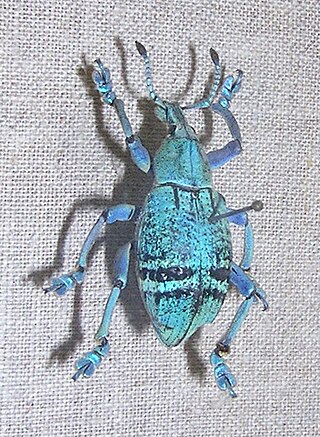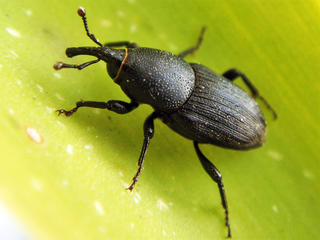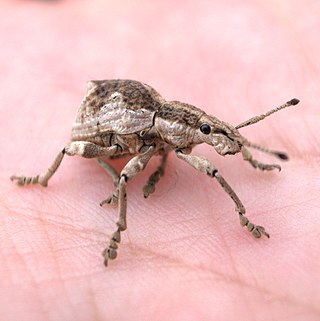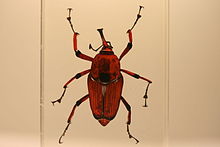
Copelatus is a large genus of small diving beetles. There are some 470 described species in the genus, found worldwide, but they are most diverse in tropical South America, Africa and South-East Asia. Copelatus are often black or brown in color, many species of Copelatus possessing visible longitudinal furrows down the dorsal side of the wings of both sexes.

Eupholus is a genus of beetle in the family Curculionidae. The genus includes some of the most colourful of the weevils. The colour may serve as a warning to predators that they are distasteful. Most species feed upon yam leaves, some of which are toxic to other animals. The species occur in New Guinea and adjacent islands. This genus was described by French entomologist Jean-Baptiste Alphonse Dechauffour de Boisduval in 1835.

Conognatha is a genus of beetles in the family Buprestidae, tribe Stigmoderini, containing the following species: They are found in the Neotropical realm.

Lampetis is a genus of beetles in the family Buprestidae, containing the following species:

Polybothris is a genus of beetles in the family Buprestidae, containing the following species:

Acmaeodera is a genus of beetles in the family Buprestidae, a group of metallic wood-boring beetles favored by insect collectors. Whereas most beetles including most buprestids fly with their elytra held out and vibrating their hindwings to give lift and thrust, Acmaedodera, however, fly with their hind wings only — the elytra are fused down the center and form a shield over the insect's abdomen, even during flight. This fact, combined with the banding across the abdomen which is common in this family, gives many of them a distinct wasp-like appearance when in flight. Several are therefore considered hymenopteran mimics.

Mecopus is a genus of weevils in the beetle family Curculionidae. There are more than 50 described species in Mecopus, found in Southeast Asia, Australia, Africa, and Pacific Islands.

Sternotomis is a genus of longhorn beetle, native to Sub-Saharan Africa. They are typically conspicuously colored and 1.8–3.6 cm (0.7–1.4 in) long.
Stizocera is a genus of beetles in the family Cerambycidae, containing the following species:

Dorysthenes is a genus of longhorn beetles of the subfamily Prioninae.
Tanymecini is a tribe of broad-nosed weevils in the beetle family Curculionidae, subfamily Entiminae.

Saperdini is a tribe of longhorn beetles of the subfamily Lamiinae.

The Sphenophorini are an important tribe of weevils in the subfamily Dryophthorinae; however, BioLib places this taxon at the subtribe level.

Episomus is a genus of beetles belonging to the family Curculionidae. Species are distributed throughout Sri Lanka, India, Myanmar, Thailand, Malay Peninsula, Sumatra, Java, Borneo, Philippines, China and Japan, Pacific Northwest of America. Many species are considered economically important, as they are pests of field beans, cotton and pigeon pea.













